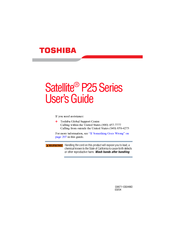Toshiba P25-S676 - Satellite - Pentium 4 3.4 GHz Manuals
Manuals and User Guides for Toshiba P25-S676 - Satellite - Pentium 4 3.4 GHz. We have 2 Toshiba P25-S676 - Satellite - Pentium 4 3.4 GHz manuals available for free PDF download: User Manual, Specifications
Toshiba P25-S676 - Satellite - Pentium 4 3.4 GHz User Manual (277 pages)
P25-S670 User's Guide
Table of Contents
Advertisement
Toshiba P25-S676 - Satellite - Pentium 4 3.4 GHz Specifications (9 pages)
Satellite P25 Series
Advertisement

